
This was the first blog I ever wrote; BoingBoing editors invited me to write a 200 pixel-wide blog to run as a sidebar in the summer of 2004.
And after this I was hooked...
Blog the Gnarl #1
"Think of black water, think of white sky, think of an island with bloogs blowing by" --- Dr. Seuss.
Bloogs of information. I think the blog is the start of the lifebox, that is, the electronic copy of one's personality. I'm writing about this idea, among others in a nonfiction book I'm working on called The Lifebox, the Seashell and the Soul. "Lifebox" is a word I invented, so don't bother trying to look it up.

Earlier this month I retired from being a computer science professor at San Jose State University. A bittersweet moment. But I'm getting too old to have two jobs. Being an author is enough.
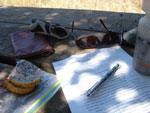
Writing is my favorite thing to do. I always have a scrap of manuscript with me, or a folded-in-four sheet of blank paper so I can work on my words. I understand things better when I write about them. In this picture I'm mountain biking the Almaden Quicksilver Park near San Ho. Note the shadows.

Shadows are so great and gnarly. If we never saw shadows normally, we'd be so excited about them. These are good because they include caustics, which are those bright lines that you see at the bottom of swimming pools, or when light is bouncing off shiny things, such as my cars. This picture is in my garage. I took it with my tiny new 5 Meg SONY Cybershot, which fits in my pocket, you can see its shadow in middle. I've always had this dream of photographing every single gnarly thing I see.

My hand is gnarly, for instance. Look at your hand and imagine it's an alien appendage. How odd-looking, how intricate, how filled with purposeful implicit structure. When I say gnarl, I'm thinking of the interface between orderliness and randomness.

My favorite kinds of computer programs are gnarly. This is a cellular automaton image made with my Capow Software. I learned about gnarly CAs from Stephen Wolfram, see NKS-SJSU: Home Page, which is a site that I made some of my students at SJSU.
Blog the Gnarl #2
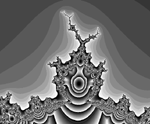
I've always loved fractals, too, speaking of computer graphics. Doesn't this one look like Ronald Wilson Reagan? I did some work at Autodesk in the late 80s and early 90s, and helped make a software package called James Gleick's Chaos, the Software. We had some great Mandelbrot sets in there. These days, there's actually a faster Mandelbrot set program called Fractal Extreme.
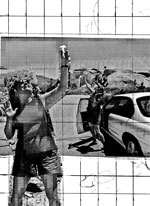
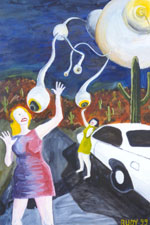
And then I made it into a painting. I also had a story on this theme called "As Above, So Below," which you can find in my story anthology Gnarl!, not to be confused with my historical novel As Above, So Below, about Peter Bruegel. I picked up that phrase from a book by P. D. Ouspensky, who ascribes it to Hermes Trismegistus.
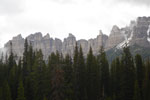
Sylvia and I took another trip out West this June to visit our daughter Isabel. This picture shows some mountains in Northern Wyoming, maybe a hundred miles east of that big park, what's it called, Yellowstone. I love how the trees mirror the jagged line of the peaks. Isabel has just put up a really great web site www.goodidrawing.com, featuring some of her drawings and comics, e.g. a giant squid attacking a ship, and a totally stuzzy excerpt from her giant comic scroll-in-progress showing some aspects of San Francisco Rock and Roll. She's looking for gigs as an illustrator, so check it out.
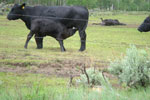
When we dipped down into Colorado, we happened to drive on a back road through a big ranch, and I saw a cow nursing a calf with a dead cow lying on the ground in the background. Is that gnarly, or what?
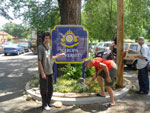
Another thing we did out West in June was that I taught a workshop at Naropa University, where the Beats used to congregate. My old poet pal/mentor Anselm Hollo is there, here's one of his poems online. My workshop was on Transreal Fiction, and at the end of one session, my students and I did an exercise where we pretended to be aliens, speaking in tongues, fanning out across the campus. It was fun. I wrote a gnarly story about Edgar Allan Poe for a proposed anthology called Poe's Lighthouse.
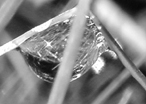
You don't necessarily have to travel a long way to see gnarl. Like here's an amazing dew drop in my back yard. It's in black and white because I'm using the image in my work in progress, The Lifebox, the Seashell and the Soul, to appear from Thunder's Mouth Press in Fall, 2005.

Really, the gnarl is all in your head, as illustrated in this brain slice. I drew this picture as an illustration for my novel about the fourth dimension, Spaceland. One thing you'll notice when you go to my websites for my novels is that I usually include a monster PDF file with a copy of all the working notes I made while I was writing the book. It's a lifebox kind of thing, you wave. My publisher Tor Books had an excellent fan artist named Taral Wayne redraw my illos for this book, so it would look more polished and less like my previous illustrated book, Saucer Wisdom.
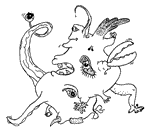
Here's one of the gnarly pictures that I drew for Saucer Wisdom. The website for this novel was made by my son Rudy, Jr. He runs a bitchin' ISP in San Francisco called www.monkeybrains.net. Rudy and I wrote a way gnarly story about Jenna Bush and the saucer aliens, "Jenna and Me." None of the print mags would touch it, but good old Infinite Matrix came through. Anyway, Saucer Wisdom was conceived as a Whitley Streiber kind of Millennial hoax, it was supposed to be notes and drawings made by a nut who's abducted by UFOs. In this case, Tor felt they might as well use my drawings as is, for verisimilitude. The picture shows what I call a "shuggoth," using a word coined by the Supreme Gibbering Master of Gnarl himself, H. P. Lovecraft. My idea for a shuggoth was that it would be a kind of random assemblage of body parts, possibly lacking a DNA blueprint.
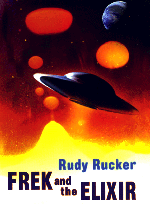
Sometimes I'll carry a particularly gnarly idea form one book to the next. I have a big (Attack of) "The Shuggoths" chapter in Frek and the Elixir. I love how the one and only thing that SF monsters want to do is to ATTACK. Frek is the longest novel, I've ever written, by the way, and it came out well. I was going for a kind of Tolkien and Harry Potter thing, an epic myth with lots of eyeball kicks and a good vibe.
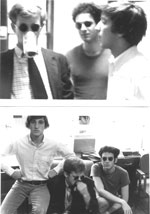
Apropos of nothing, here's two pictures of my college friends drinking beer in my dorm room in 1965. On the top, that's Gregory Gibson, Don Marritz, and Rob Lewine left to right. Those were the days. Lewine art-directed the photo shoot; he was in love with A Hard Day's Night. This would be in the Mary Lyons dorm at Swarthmore College, where my oldest daughter Georgia went as well. Georgia and her friend Margo Mooney ran a company called Pink Design, Inc., for the last few years. These days Georgia is still in New York designing and illustrating books, websites, and logos. Her company is now called Georgia Rucker Design.
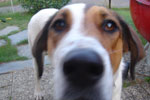
Gregory Gibson, by the way, has been a huge influence on me as an author. (He's not the same person as William Gibson, also an influence.) Greg was my roommate, senior year in college 66-67, and in later years we corresponded a lot. He once remarked to me, "It would be nice to write science fiction, but to have it be about real life," which was, in a nutshell, the idea for the Transreal style of science fiction that I often use. I don't always write Transreal, though, so don't jump to any conclusions about what you read in my books. I gave a talk at ReaderCon in Summer of 2003 that discusses some of the other styles I like to use. In college, Greg's nickname was Dog, and mine was Pig, chosen by me in literary homage to Pynchon's Pig Bodine, and acceded to with insulting alacrity by my peers. Greg and I always liked to laugh about dogs, about how we read so much into their expressions, when their faces are just three black dots. Once in college Greg walked around wearing a big paper mache dog head mask for a couple of days. It's possible that we were celebrating Lincoln's Birthday. Those were the days.
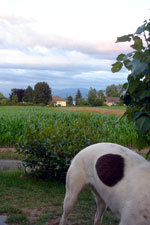
Back to the theme of gnarl, here's another picture of that same dog, whose name is Pitch, and who lives with my brother-in-law Henry near Lake Geneva in Switzerland. "Isn't that a beautiful spot!" exclaimed Henry's daughter Stella when I showed her this picture. That spot on Pitch's back, it's computed by gnarly cellular automata in the embryo. Alan Turing figured this out in his seminal paper "The Chemical Basis of Morphogenesis" [Be sure and look at page 25, where Turing, after a huge amount of computation produces a spot like that on Pitch's back.] When I moved to Silicon Valley in 1986, Greg Gibson said, "That's great. It'll be as if Keats went to work in a textile factory in Manchester! The dark Satanic mills!"

The sun's going down. Did I mention how exciting I think clouds are? These are in Denver, right before Sylvia and I flew back to sunny Californee. I just pissed away a whole day working on my blog.
Blog the Gnarl #3

Let's start today with a duck painting I call "Da Nha Duc," who is also a minor character in Frek and the Elixir. It was Sylvia's idea to give him a Vietnamese name. We both have (had, in my case, retiree that I am,) a lot of Vietnamese students at our teaching jobs, and we've grown to enjoy all things Vietnamese. I got the inspiration for my Duck from, of course, the Good Artist, the Duck Man, Carl Barks. [Google for your own Barks link here.] I do a couple of paintings a year, I got into the habit while I was writing my Bruegel book. Apropos of linking to my stuff, I remember a great line in David Foster Wallace story where some stoners are watching TV and the ubiquitous 80s pitchman Ed McMahon comes on, and one of the slackers says, "Sell it, Ed." I love Wallace's fractality, the eidetic flat spoken language style, the drive to dig beneath the surface.
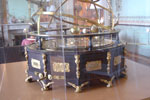
This is an orrery that I saw in the Museum of the History of Science in Geneva, Switzerland in July. An orrery, by the way, is a tabletop model of the solar system, with a crank you can turn to move all the planets and moons around. The name stems from the owner of one of the first these devices, one Charles Boyle, Comte d'Orrery in Haute Savoie, which is the Alpine part of France south of Lake Geneva.
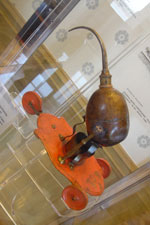
It's a small museum, maybe eight small rooms on the two stories of a house, parquet floors and enchanting prospects from every window, most of the windows open to catch the breezes from the lake. Glass cases hold brass scientific instruments: microscopes, telescopes, barometers, Leyden jars, spectroscopes, orreries and the like. Stands to reason these instruments would be found here, in the nation of watchmakers, indeed quite a few of them are of Swiss manufacture. The item above is a little car that poots along under steam power. An artificial bug.

Here's two real Swiss bugs --- harrumph --- reproducing. Is that a great picture, or what? My SONY Cybershot rules. This reminds me of a drawing R. Crumb did of a farmer and his wife doing something not to be described on a family web page. "Havin' a Good Time and Still Gettin' the Plowin' Done!" I love the eye on the guy on top. Once in a Boing Boing print interview, I asked SubGenius Ivan Stang how he could support himself and he said, "I have a wife and a color television and they both work."
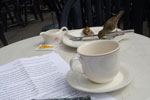
I should be working on my book instead of blogging. And I should let the main boingboing page catch up with my sidebar. I thought it was great the way John Shirley was just pasting in whole articles last week, and I may do that too, eventually. Thanks, John, for the great introduction. Once I made John go to Esalen with me, and he didn't like it, and afterwards he said, "Rudy, how can you expect me to fit in there! I used to break beer bottles on my head and dive off the stage." My work in progress is, as I mentioned before, but who really scrolls that far back into a blog post anymore than they look at surveillance videotapes of their conversations, my w.i.p. is The Lifebox, the Seashell and the Soul, the fruit of my twenty years in the Dark Satanic Mills of Silicon Valley. Today I'm trying to analyze why some books sell so many more copies than others. Trying to find the handle on society.
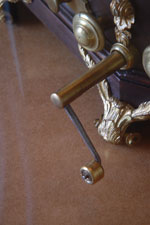
The orrery was turned by this little crank on the side. The secret of life! A valuable and universal metaphor for thinking about social movements is the sandpile model, first presented in a paper by physicists Per Bak, Chao Tang and Kurt Weisenfeld. Also see the really terrific book Ubiquity by Mark Buchanan. The idea is to imagine dropping grains of sand down onto a table and looking at the sizes of the avalanches you see. Think of a sand grain as a book you publish. Think of the size of the avalanche as the number of copies the book sells. Or think of a sand grain as a blog post and the avalanche as the number of links to the post. Or think of the sand grain as a blog post (or book) that you read, and the avalanche is the number of neurons in your brain that fire. To make a long story short, after sand's been dropping on the pile for awhile, the pile is in a "critical" state, which means that avalanches of all sizes can occur and there's no predicting the result. At this point you ought to look at a great Java sandpile applet showing the sandpile, by a cute Russian guy called Sergei Maslov. (I know he and his wife Olga are cute from the photos on his site.)
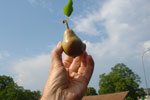
To use Sergei's sandpile applet you have to have Java 1.4 installed on your machine --- note that Microsoft no longer ships its operating systems with Java enabled. So if the applet looks blank, you need to go to Sun's page and click Download J2SE JRE. Now that you can see the sandpile applet, click CONTINUE to bring it to life. Keep feeding it for awhile by clicking on it. All the green cells have three grains of sand stacked on them, and when you click you are stacking. You're seeing avalanches. When they hit the edges the sand falls off (unless you click one of the BC Open buttons, which make the sand "wrap around"). Now after you've clicked for awhile the sandpile is in the "critical" state and you'll notice that some clicks of additional sand have big effects and some don't. Clicks are books being published, moving fronts are the readers.

The distributions of sizes of things in critical states obey what's called power laws, meaning roughly that your popularity is the reciprocal of your rank, or of your rank squared or cubed some such. It makes for a curve that's real high at the left and then tails off towards the horizontal. The tails are fat, though. (A statistician sent me an Xmas card last year saying, "May all your tails be fat.") The number of links that a given blog has seems to obey a power law, see this graph by blogger Chris Gulker. Speaking of links to bloggers, I'll mention Kathryn Cramer's blog. Kathryn was long interested in alternative literature forms, like the branching text things you can do with Hypercard. The blog is the new medium. Her site has some links to interesting essays by her father John Cramer, regarding his Transactional Interpretation of Quantum Mechanics, which I much like as an alternative to the Copenhagen and Many Worlds interpretations. Also (what power the blogger imagines he or she wields!) Scott Drave's site, he's made a gnarly DVD called Spotworks. And hi Susie, and Mom, and Dad, and ...
Sell it, Rudy.
Blog the Gnarl #4
For the top of today's entry, I want to plug my daughter Isabel's drawing and cartoon site again. www.goodidrawing.com, featuring some of her drawings and comics, my favorite for now being San Francisco Rock and Roll. She needs illustration gigs! Just talked to her on the phone; at a County fair in Wyoming, she and three of her woman friends entered a contest where they tried to wrestle a pig into a fifty gallon drum. The pig squealed a lot, and fought them to a standstill. I hope she draws a picture of it.

This picture above was taken in a square called Bourg de Four in Geneva, where Sylvia and I spent most of July. I like how the gnarly clouds mirror the gnarly roofs. I recall that at the Digital Biota 2 conference in 1998, I heard a-life visionary Chris Langton give a talk in which he pointed out that we shouldn't think of cities as unnatural. We are part of nature, and cities are our hives. There's no border between man and nature.

I'm always trying to get good pictures of water. This is a bit of lake Geneva, near the Museum of Science. By the way, I got a corrective email about Charles Boyle, who was Earl of Orrery, not Count as I reported, and Orrery is not a place in Haute Savoie. Whatev. Earl of Duke, meet the Duke of Earl. Re. this picture, I love it when people paint water showing the shapes of light and dark. One thing about Lake Geneva, if you swim near ducks in hot shallow water, you get these parasites called puces de canard, which literally means "duck flea," but these things are sicker than that. They're transparent worm-like critters called in French "cercaires," and judging from the picture halfway down the page I linked here, they're, double-sick, split at one end, they spend their larval youth in snails, then come out into the water and look for ducks, get into the ducks and systematically infect them, sending their eggs out in the duck poop to infect the snails on the bottom of the lake. One hot day we swam in shallow ducky water in Crans, and error, didn't shower and towel off, and the next day we had, like chigger bites. My in-laws had warned me, but I didn't listen. Live and learn. If I'd told customs I'd had duck fleas, who knows, I'd still be on Ellis Island.
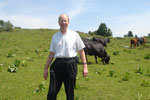
Still in Switzerland, here's a picture of my former-titan-of-industry, retired-but-still-working-his-ass-off computer hacker pal, John Walker, co-founder of Autodesk, one-time employer of mine, and transreal inspiration for The Hacker and the Ants. (N.b., the way cool cover for Release 2.0 of the novel is by daughter Georgia Rucker. Sell it, Rudy.) John invariably wears the same outfit, the short-sleeved white shirt and black pants. Antarctica, Egypt, inside the Sun, at the Ascot Races, fixing a car, in the Antland of Fnoor --- always with the white shirt and pants. He says it simplifies his life by pruning the choice tree. We hiked to this nice place above Lake Neuchatel called Creux du Van. An amazing cirque (horseshoe shaped cliff) and lots of Swiss cows.
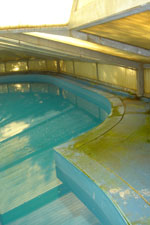
Near the end of The Hacker and the Ants, the hero Jerzy Rugby is attacked by killer robotic ants and is nearly bitten to death beside a primitive indoor swimming pool found in the house of his not-so-innocent and in fact downright nefarious former boss Roger Coolidge. Here's a picture of the pool at Walker's house. He has the largest website I've ever seen, including (under "Science Fiction, Original Stories") his own last chapter for The Hacker and the Ants, as he wasn't quite satisfied with my ending. In John's ending, Roger Coolidge wasn't killed after all, and he comes back to patiently tell Jerzy Rugby what a lamer he is.
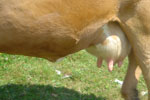
This is the "Money Shot" that the California Cheese ads on TV never quite deliver --- one of the cows near Creux du Van. My Swiss step-mother-in-law Adele saw this picture and said, "Oh, it must have been about four o'clock." Going from the size of the udder. Like a sundial. I'd like to come back as a Big Sur cow if I get reincarnated. Standing on those steep hills staring at the ocean all day. Or a crow. Bruegel loved crows.

When we got back to the States we stopped in NYC for a couple of days to visit Georgia and her husband Courtney. We were over in Astoria (Queens) one day and we hit this really great little museum for the Japanese-American sculptor Isamu Noguchi. This image kind of matches the cow.
Blog the Gnarl #5
I've been blogging too hard, I'm not gonna do much for a couple of days. Meanwhile there's always my first four entries, the info is still fresh. Blog the Gnarl in a single file. Also, for a change, I put up a big version of this picture, showing me on top of a low mountain near Mt. Blanc.
The day I took this picture of myself, I'd hiked up to a spot called Petite Croisse Boulet (1900 m), which was a thousand meters higher than our hotel. Great views of the Mont Blanc.
I picked up an ant because I knew he would nip at me with his mandibles, and I wanted the feedback from this humble mountain denizen. I wrote a haiku.
Halfway up the mountain,
As far as I can go.
An ant bites me.

In the afternoon as I hiked back down, some eight hours after starting, it clouded up and eventually started raining. I passed through a meadow with a low, tin-roofed barn, and with pines around the meadow. I heard a loud noise from the barn --- a spring inside? A camouflaged machine? No, the sound was the rain on the barn roof, a lovely sound, and now in the meadow I heard cow bells, a herd of a dozen cows making their way in a line to the shelter of the trees. Nobody there but me, scattered raindrops cooling my hot head, the rain on the tin, the cow bells, a moment of perfect beauty, a moment to live for.
Further down, the edges of the village, I saw another vignette. Loose chickens
scratching in the wet dark green grass. Their bodies such canonical chicken
shapes. A gray-haired peasant and his wife are trying to push a wagon of hay
bales into their barn. Their son (grandson?) on a tractor is maneuvering to
help push. I wave and smile, they wave back. We're in the same rain.
Blog the Gnarl #6
I've been working on The Lifebox, the Seashell and the Soul, creating some computer graphics relating to aspects of society viewed as a parallel computation. So much to do.

Language has a branching quality, with each word suggesting a number of others. Indeed, you can think of words as the nodes in a network. Imagine a drawing with a dot for each word and with a link between any two words which you associate with each other.
John Walker recently helped me run a little computer experiment with me to quantify the word linkiness distribution. Rather than wrestling with the vague notion of which words suggest which other words, we took an electronic dictionary file and decreed that any two words are linked if either of the words appears in the dictionary definition of the other word. The dictionary has some 130,600 words. Then if a word has L links, then L will be some number between one and 130,600, and we can think of L as characterizing the "linkiness" of the word.
Walker computed the linkiness L of every word in the dictionary, and for each level of linkiness, he counted how many words N of that kind there were. N can in principle range between the smallest and largest possible number of words, that is between 0 and 130,600. And we found that in this case N is indeed usually equal to a constant divided by L raised to some power D. The law we came with, using some Mathematica curve-fitting, has this form.
N = 1,000,000 / L^2.4
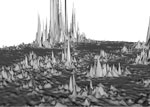
This is an inverse power law, akin to the one for the linkiness of the web in Albert-László Barabási and Réka Albert, "Emergence of Scaling in Random Networks," Science, Vol 286, 1999. Links to this and many more of Barabási's papers. The particular picture above shows a power law population distribution based on the Zeldovich rule as described in Damián Zanette and Susanna Manrubia, "Role of Intermittancy in Urban Development," Physical Review Letters 79, pp. 523-526, 1997. I want to go to Zeldovichgrad! Plan to log some time there soon. What cyberspace really looks like. Some of those peaks go up a thousand miles, a hundred thousand miles, to the mouth of God. I think my next novel will be called Crazy Mathematicians.
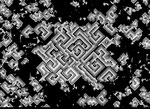
How do rumors, fads, opinions, crazes spread? A bit like forest fires. I like the generalized NLUKY rule that I defined for Cellab. This is the Rainzha NLUKY rule, named after Rainbow, the brain-eating Little Kidder in my novel Software.
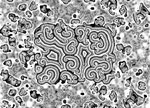
A better scrolly rule is this guy, known as the Hodgepodge rule. A silent explosion in deep space. "I have an idea!"
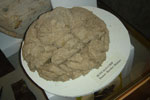
Not all ideas are good ones. This is a display in the Museum of the Mountain Man in Pinedale, Wyoming. The label says "BUFFALO CHIP: Donated by Bartley Skinner."

Time for weekend fun. Shakespeare Santa Cruz, the beach, maybe the Santa Clara County Fair. I fade into the sunset --- calme, luxe et volupte.
Blog the Gnarl # 7
Punch the clock, it's Monday.

I just checked Bruce Sterling's blog. He gets paid for it! Gotta get up pretty early in the morning to get ahead of this ole boy. He sent me a link to a blog mentioning the Nokia Lifeblog.
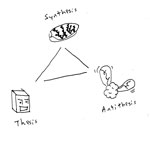

The seashell I'm talking about is one of these cone shells, which Stephen Wolfram is so daffy about, see this page in his online version of A New Kind of Science. In a nutshell, a cone shell is a naturally occurring example of a gnarly pattern that's probably generated by a rather simple cellular automaton rule like Rule 110.
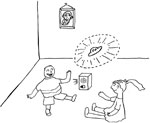
Now the lifebox is something I've been talking about ever since Saucer Wisdom or, come to think of it, even earlier, it goes back to my short story "Soft Death". This picture shows some children talking to their dead grandfather's lifebox. The hovering saucer has Saucer Wisdom narrator Frank Shook inside it.

[Here's a picture of Frank Shook in my garage in Los Gatos.] In my science-fiction tales, a lifebox is a small interactive device to which you tell your life story. It prompts you with questions and organizes the information you give it. As well as words, you can feed in digital images, videos, sound recordings and the like.

[Here's my mother.] Once you get enough information into your lifebox, it becomes something like a simulation of you. Your audience can interact with the stories in the lifebox, interrupting and asking questions. The lifebox begins by automating the retiree's common dream of creating a memoir, and ends by creating a simulation of its owner.

[And here's my father. I miss them every day.] Why would you want to make a lifebox? Immortality, ubiquity, omnipotence. You might leave a lifebox behind so your grandchildren and great-grandchildren can know what you were like, you might use your lifebox as a way to introduce yourself to large numbers of people, or you might let your lifebox take over some of your less interesting duties in your daily routine, such as answering routine phone calls and email.
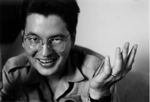
Here's a picture of Bruce Sterling from, like, 1983, when I was freelancing as a pre-cyberpunk SF writer in (one of God's jokes) Jerry Falwell's Lynchburg, Virginia.

William Gibson came to see me that day, too. Twenty-one years ago. I was driving a 1956 Buick. T. w. t. d.
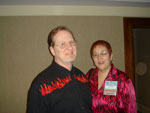
Here's a recent picture of John Shirley and wife Mickey, taken at the San Jose BayCon a couple of months ago. There were like only three or four people at BayCon who had read any of my books Ain't it awful?
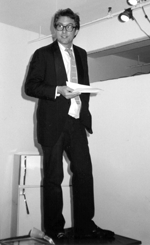
Doddering back down memory lane, here's a picture of me getting the Philip K. Dick Award for Software in 1982. I lifted this and Bruce's picture from my files for my essay collection, Seek! Ransacking my hard drive to find more shovelware for the furnaces of the blog.
This is a really startling graffito I saw in Rimini, Italy, when I was there to get the Medal of the Italian Senate a couple of years ago. It's so gnarly that I put the big image up so you can click on the little one to see --- harrumph --- the details. I don't think an image like this would stay on a wall very long in America. It's kind of scary to think that Nokia Lifeblog is already happening. The lifebox is coming true.

[Reflections in a Denver office building, in search of Neal Cassady.] I hadn't originally realized how essential images, videos, and sound clips would be for the lifebox, but, duh, that's obv, isn't it, especially since writing is, like, hard. The linking issue is the biggie that makes the Lifeblog, or the regular blog, still not quite like a lifebox. Well, do a first pass by some automated linker, tweak it a little, and then let it loose. Shovelware your lifebox data onto the web and let people wiki up the links themselves. I'd like to make the website for The Lifebox, the Seashell and the Soul be wiki style, as I don't want to have to maintain it. Also would make it a McLuhan-cooler medium. But what about control? I don't quite get why a wiki page doesn't get attacked by bots who replace all its links by links to commercial sites. Seven Lucky Overseas Welcomes You to Triple Happiness Rudy Rucker Lifebox, No Prescription Needed!
Blog the Gnarl # 8
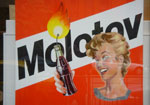
[Cool Russian Pop Art painting I saw in a gallery window in Denver near the train station. Anyone know the artist's name?] A reader alerted me to a recent news story about a "Soul Catcher" chip, described by scientist Chris Winter at British Television laboratories. The idea would be to put a chip in your brain that records all of your sensory experiences so that you, or others, can play it back. A lifebox implant, in other words. But the scientists admit this was just a Moore's Law game, and that they have no idea how to make the software.
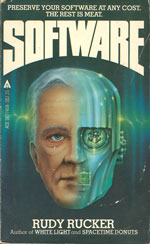
In order to talk about Moore's Law, it's useful to brush up on scientific prefixes. At present it goes up to yotta (like lotta) for 10^24, and I suggest that after that we have xenna for 10^27 and watta for 10^30. Suppose we measure the power of a chip in flops, that is, in the number of (floating point) operations it can do in a second. This is a little more general than hertz (clock cycle per second), a little less general than IPS (instruction per second).
This clickable graphic from my work in progress, The Lifebox, the Seashell and the Soul (Thunder's Mouth Press, projected for Fall, 1995) shows a little semi log Moore's law graph showing when we might expect to get machines with an exaflop and wattaflop capacity. I'm estimating that you need an exaflop machine in order to have the hardware to simulate a human brain. But you would need a wattaflop machine in order to evolve the necessary neural net (?) software to simulate a human brain. You need so much power because finding some human-like brain software is a huge search problem, to be done by basically simulating three billion years of evolution.
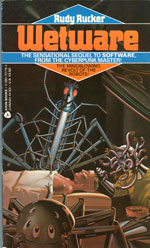
Really the way to go is, of course, to turn to biology. But we're already doing that when we fuck. Who needs more machines anyway? The Wares: soft, wet, free, and real. Dept. of Bitter Wheenking: Avon has let my second ware novel Wetware go out of print. Speaking of brain recording, wasn't Strange Days a great film? Wow, I just found the script online. If only they hadn't gone off into that downer sex-murder thing. There's so many more interesting things you could do with a brain taper. See the political cartoon, "When Monica delivers the pizza," by R. Crumb, Rolling Stone, November 28, 1998. Sadly not online. Links anyone? Scan it and post it for me?
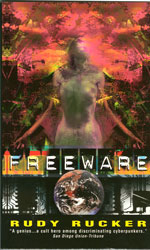
I have a movie option out on Freeware; to an outfit called Directed Evolution Networks in Seattle. As reported in Boing, there was recently a Variety story about some interest in Master of Space and Time. I'm still hoping for more news on that. Some people don't realize there's four of my Ware novels, so might as well put the fourth cover in as well, Realware.
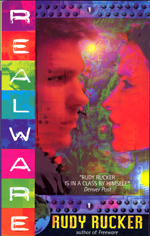
Sell it, Ed.
Blog the Gnarl #9
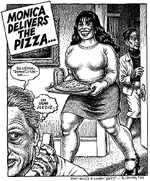
Mailbox: You readers have been really helpful. If this blog was all I ever did, I could see getting into a nice feedback loop, which makes me think of Martin Gardner telling me that at some point his Scientific American column "Mathematical Games" became self-activating, in that he got enough info from readers to keep it going. So thanks to Jeremy Hulette, for pointing me to this GIF of R. Crumb's drawing, "When Monica Delivers the Pizza," found on a page selling a konky kollection kof King Krumb's killustrations. The letter "k" was considered intrinsically hip and funny in the late 1920s and early 1930s. Kind of like "x" was in the late 1990s and early 2000s. For kicks, I had the letter "g" be the fashionable letter in the year 3003 in which I set Frek and the Elixir.

Some readers have been asking me where I saw the Dr. Seuss quote about "bloogs" that I mentioned in Blog the Gnarl #1. Well, I don't remember the precise book. My wife and I read, like, all the Dr. Seuss books to our kids. It was a kind of low-level book, maybe it was The Thinks You Can Think. Where I actually found the quote for my blog is in a second-hand source, to wit, my transreal novel White Light, which is set in the period when Sylvia and I were reading a lot of Dr. Seuss books to the etc. The lifebox replacing the life. Two relevant quotes from this lively tome:
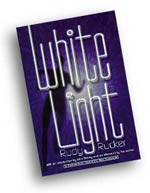
(White Light Quote 1) But that was not all. I began noticing things that didn't fit into any theory of physics I'd ever heard of. There were blobs of…of stuff drifting around everywhere. Little pin-point bubbles and big dopey-looking balloons were filtering through the objects around me. With their dark wrinkles and foolish nodding, the big ones made me think of a drawing in one of Iris's Dr. Seuss books. I decided to call them bloogs like the good doctor had.
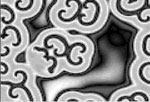
(White Light Quote 2) "As you know from my paper, I'm working on
a hyper-matter theory," said Nick. "My idea is that there's a different
type of matter…gobs of invisible jelly floating around. That net of laserbeams
is supposed to herd the globs into the vat, and the little engine at the bottom
is to condense them. The rest of the stuff is just to detect the condensed globs
of hyper-matter."
"Bloogs," I said.
"What?"
"Think of black water, think of white sky. Think of an island with bloogs
blowing by," I recited. "That's from Dr. Seuss. You're looking for
bloogs!"

Synchronistically enough, twenty years after writing White Light with a character named Nick, I befriended far-out physicist Nick Herbert. This is me and Nick at an April Fool's Day Parade in Boulder Creek. Yes, I'm wearing lipstick.
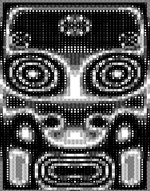
Jeff Beene reports that the Molotov cocktail painting is by is Alexander
Kosolapov. This picture here is an early CA that I made; it's called Maxine
Headroom, and it ran on a low end 1980s PC in text mode; you turned the monitor
on the side to get this nice aspect ratio. Would be nice to set up a room of
them.
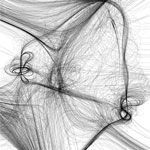
Speaking of computer art, here's an image by Casey Reas who's doing nice gnarly art with machines. I met him at conference at UCLA this spring involving art and computers.
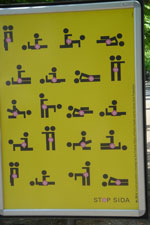
"Woof! und hallo bei den Swiss Bears!" In Geneva, Sylvia and I saw a gay pride parade featuring a float of the Swiss Bears. The picture is a condom ad that was all over town for the parade. They lit up Geneva's enormous jet d'eau fountain with pink light. The Swiss pretty much do whatever they like.
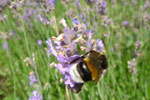
Jacob Davies, programmer at a web software company wrote a note posing a key question about lifeboxes and blogs. "I am kind of fascinated by the whole lifebox thing but I do wonder who has the time to watch real-time video of someone elses life. Isn't it just going to wind up being like those endless hours of videotaped vacation that sit on peoples shelves? At least with the written version you get the edited highlights all wrapped up. Photos & edited audio & video, that I can see being interesting though, but most people suck at editing which is kind of the problem. I guess if the box was smart enough to edit for you it wouldn't be so bad."
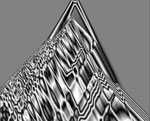
Relevant quote from my current draft of The Lifebox, the Seashell and the
Soul: "One imperfect feature of human language is that our rate of
information exchange is limited to very low rates. Yes, you can send a multi
megabyte-book manuscript by email in a matter of seconds, but the human listener
at the other end will take hours or even days to read it. We're stuck with low
bounds on both the speed at which we can listen to someone talk and on the speed
at which we can read with full comprehension. // The problem of finding time
and patience to take in other people's outputs is an obstacle to wider-ranging
empathy. Many power struggles in human societies center around determining whose
voices get heard. To be heard is to be understood and, to some extent, sympathized
with. // To be a great artist is to have the ability to compress your lifebox
down to an appetizing and digestible snack that people readily wolf down. And
then your information blooms inside them."

Dan Mushrush sent me the ultimate Beavis & Butthead quote r.e. futurology. "The future sucks." I like that as much as what the boys would say whenever they'd see a video with writing in it. "Words suck." So writing about the future sucks doubly. And somehow that makes me think of the Godlike Howard Stern, King of all Media and last-ditch freedom fighter, who has a nice picture of my fellow-novelist Pam Anderson on his site today. Also great rants against that-nameless-asshole-who-stole-the-last-election-and-plans-to-maintain-a-drumbeat-of-terrorism-alerts-to-make-us-too-scared-to-vote-this-time. But don't get me started on that topic. Better to stick with Pammie.
Blog the Gnarl # 10
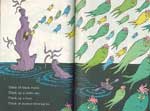
Whoah! Brian Bruxvoort writes "It was indeed Dr. Suess' Oh, The Thinks You Can Think! that you quoted, and I've scanned and attached the proof. I had the wonderful surprise of reading it to my daughter a couple weeks after reading it in White Light last year." Brian kindly encourages me to keep on blogging, and maybe later this fall I will. If and when I do, I'll announce it on Boing. Oh, and mathematician and SF writer Jonathan Post asked me to blog the math page on his huge site. Jonathan used to drive the moderators crazy at the big Santa Fe Artificial Life conferences when they'd ask for questions from the audience after a panel, and he'd be first in line down on the floor, ready to unleash a five minute minilecture disguised as a multi-part question.
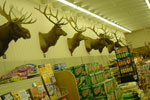
The picture above shows a wall inside Faler's General Store in Pinedale, Wyoming where Isabel lives. She'll have her jewelry biz back online soon. One last thing to plug. I'm going to be giving a workshop on Friday Oct 1 to Sunday Oct 3 called "Chaotic Mind" with demon chaotician Ralph Abraham at the Esalen Institute.
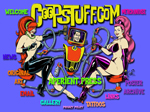
One last link tumbles in, this one to the merchandising page of Chris Cooper, known as COOP in the hallowed pages of the great art magazine Juxtapoz.
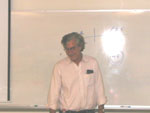
This last picture was taken by my student Alvin Cho during my very last Computer Graphics class at San Jose State. Goodbye, Mr. Chips. Till the next guest blogger kicks in, here's last week's Rudy blog and this week's Rudy blog. Adios, mischief-makers.
Blog the Gnarl #11 (Encore)
I see my guest blog is still up even though I haven't added anything since last Thursday. I thought I was done. Okay, look, here's a final infodump, unused bits culled from the working notes of my work in progress, The Lifebox, the Seashell and the Soul. But, sorry, no links or pictures today.
Geek Joke for the Preface
I was in fact tempted to call this tome Early Geek Philosophy. As many will know, in early 20th century American slang, "geek" had the specific meaning of a carnival sideshow performer who would bite the head off a live chicken or eat raw liver. In practice, a carnival geek was a person whose primary skill was a high tolerance for grossness, ridicule, and pain. By the late 20th century, with carnivals a rarity, a "geek" was simply a person who seemed very different from other people, usually a person lacking in social graces. Because so many of these types of people became involved with computers, "computer geek" became a natural name for programmers in general. Given that computers have been around for considerably less than a century, in the grand historical view of things the computer mavens of our time are still early geeks, so call me Rucrates!
Working with computers isn't quite like biting the head off a live chicken, but it's close. The thing is, computers are somewhat repellent. Computer cases are a dull, ugly shade of beige. Computers are the tools of telemarketers, dot-commers, oppressive governments, and digital snoops. Many of us have office jobs where using a computer is part of the daily grind. The damned things never work like you expect them to for more than a few weeks at a time. You have to constantly upgrade their software and hardware. They flicker and they make an ugly noise. A lot of us lost money on computer stocks in the Dot Com Bubble. And so on.
Who but a chicken-head-biting geek could stand to spend much time with such machines? What could less life-affirming, mind-manifesting, or philosophical than computers? Ah, but if you look, the secrets of life float just beneath the pulsing screen.
Bitching About Computer
Occasionally I see an old movie from the Thirties, or Forties or Fifties --- and I'm always struck by the absence of computers. How peaceful things look without those demanding machines; how leisurely and free those old-time actors seem.
When they're done work for the day, they leave their office --- without having to wait through any kind of computer log-off procedure. When they arrive at their offices in the morning they get on with their business --- without spending an hour or more combing through email.
My First Computer
The first computer I saw was when I was in high-school in Kentucky, maybe forty years ago. I was in the math club, and our group got a tour of the computing center at the University of Louisville.
The thing that impressed me most on that first computer excursion was a large mechanical drawing device --- they called it a plotter. The plotter was shaped like a sand box; it was a square hollow frame four feet by four feet. In the middle of the plotter was a bracket-mounted pen held in place by tight pulleys. The pen was supposed to draw on a three-foot square of paper, but at the time of our visit the plotter was out of order --- nothing unusual for computer hardware then or now.
Even though the plotter wasn't working, the idea of it stayed with me. By speeding up and slowing down two little pulley motors according to some equations, a computer could move a pen around to draw pictures. Some of the pictures were on the walls. I seem to remember a spider-web and perhaps a mechanical drafting of a nut or a bolt. The friendly white-shirted nerds who ran the computer center tried to explain how they used punch-cards to feed simple equations to the computer that ran the plotter --- but their explanations didn't make any sense to me. The important thing was the visual evidence of the plotter: A computer could control a device capable of generating smooth shapes. Computers were more than punch-cards and teletype print-out.
In math class at that time --- I think this would have been the eleventh grade ------ we were studying equations with things like cube roots, exponentials and polar coordinates. I wished I had a plotter to play with, so as to quickly turn lots and lots of equations into pictures. I also wished that I could understand how to use punch-cards to put equations into a computer. I was hoping there might be a way to learn this without having to become a complete Martian like the computer-center guys.
Your experience with pencil-and-paper computations, such as multiplying numbers, may have left you with the impression that a computation has to terminate with an answer. But this need not be true. A computation can be ongoing, with no specific termination time contemplated --- think of a flowing river or of a computer screen-saver. Each of the successive states is an output linked to a moment in time.
Speaking of time, how long does a computation continue? We won't impose any bound at all. Certain kinds of computation will indeed signal when they've arrived at a desired result ¾for instance by beeping or by printing a result ¾ and then halt in the sense of no longer changing their states. But there's a sense in which such computational processes continue after their halting point. It's just that after they halt they remain in a constant state.
For a computer that's supposed to calculate a number halting, is usually viewed as a good thing, but for a living being --- which is also a kind of computation ---halting has the bad connotation of death. Most naturally occurring computational processes are things that we like to keep going as long as possible.
The Turbulence Pattern Known as a "Von Karman Vortex Street"
As a sometime fiction writer, I like to think of Von Karman Vortex Street as a place, possibly located somewhere near Miles Davis's Green Dolphin Street and the Firesign Theater's Non-Euclid Avenue.
Fredkin's Billiard Ball Computer
In the 1970s, the computer scientist Edward Fredkin gave a theoretical proof that, if you idealize away all of the real-world crud, you can make a universal computer from billiard balls bouncing around on a sufficiently large table. At the time this seemed like a surprising result, but by now it's beginning to seem likely that almost all of the physical systems we encounter are universal, just as they are.
Now, in reality, you can't actually build a Fredkin-style billiard ball computer, for the balls' large-scale motions will quickly display the slight inaccuracies in your starting conditions, not to mention the influences of effects as small as gravitational forces from your body as you walk around the table observing the experiment. The system won't behave in the repeatable digital fashion that you'd planned. It's not realistic to expect the motions of ordinary objects to behave like a digital computer. We live in an irredeemably analog world.
But Fredkin's proof-in-principle encourages us to believe some form of Wolfram's Principle of Computational Equivalence, which claims that essentially all physical systems embody universal computations fully rich enough to emulate anything that happens inside an electronic machine.
Bitter Ranting Against Quantum Mechanics
I might as well say straight out that when I try and explain quantum mechanics, I feel like a cross between a browbeaten atheist reciting Bible stories at Sunday school, a frightened former landowner singing the praises of Stalin, and a one-legged man trying to tap dance.
Entanglement is a popular topic for quantum mechanical mystery-mongering. But it's easy to read too much into it. If you heat a large flat pan of water, steam bubbles will appear at the same time on opposite sides of the pan. This doesn't necessarily mean that there's a magical faster-than-light entanglement between distant pairs of bubbles. It can simply mean that the bubbles are the result of a lower-level common cause.
Philosophical ontology and computer science's Object Oriented Programming (OO) as in C++ or Java.
Everything is mathematics implies Everything is a set implies Everything is an object.
Objects are better than sets, as they have function pointers, they are a verb as well as a noun.
An interesting thing about OO (object-oriented) languages is how they are like set theory. We build up class definitions from the primitive byte variables (of various standard lengths, recall that a floating point real is just four(?) bytes, for instance) like the way set theorists build up all of mathematics from commas and pairs of brackets. Objects are even better than sets, though, as they contain function pointers and corresponding blocks of code, that's a cool thing about the von Neumann architecture is that we have instruction pointer and data pointer, so we crawls over both data and code.
Software engineering teaches us to look for patterns in our lives.
For many applications, the user might not need for a robot to be fully autonomous. Something like remotely operated hand that you use to handle dangerous materials is like a robot, in that it is a complicated machine which imitates human motions. But a remote hand does not necessarily need to have much of an internal brain, particularly if all it has to do is to copy the motions of your real hand. A device like a remote robot hand is called a telerobot.
I have a feeling that, in the coming decades, telerobotics is going to be a much more important field than pure robotics. People want amplifications of themselves more than they want servants. A telerobot projects an individual's power. Telerobots would be useful for exploration, travel, and sheer voyeurism, and could become a sought-after high-end consumer product
Weinberg's Put-Down
There's a good reason why Dell and Intel don't market Turing machines or Rule 110 Cellular Automata. Universality isn't everything.
It's possible that electronic computers are only a passing fad.
In a human being, changing the microcode is analogous to undergoing brain surgery or (in a temporary way) dropping acid; flashing the BIOS is akin to having a peak conversion experience; and changing the operating system is comparable to adopting a behavior-modifying regimen such as meditation classes or group therapy. A pathological neurosis can be so deeply ingrained a system bug that one has to dig down quite far to change it.
No intelligent robots for at least a century. Depending on how you look at it, this may seem like either good news (we won't be replaced by smart robots) or bad news (we won't figure out how to build smart robots very soon).
The neural net for recognizing smiles and frowns, for instance, is just a mound of some three thousand real-valued numerical weights. You might hope that if you analyzed the weights, you'd discover that each of the hidden layer neurons is in fact learning to recognize a specific aspect of facial expressions. Perhaps the first neuron notices whether the left corner of the mouth bends down or up, perhaps the second focuses on the wrinkles or lack thereof in the face's brow, and maybe the third pays attention to the twist of the mouth's right corner. But this isn't necessarily the case. In many neural nets there's no easy way to pick out what it is that each individual hidden-layer neuron is learning. Indeed, the more compact and effective a neural net becomes, the more opaque it becomes, and the less amenable to human understanding. [Actually I don't think this is usually true.]
Unsupervised Learning Raps
Unsupervised learning is when K goes out in the playground and a girl won't get off the seesaw to give him a turn, and K bites her on the butt, but she's wearing thick snow pants and doesn't notice, but even so K feels bad and dumb. Unsupervised learning is when K looks for someone to marry and ends up with the girl he tried to bite in first grade. Unsupervised learning is when K finally tells her that old story and she divorces him. Error! Unsupervised learning is when L drinks so much beer at age sixteen that she throws up, learns to drink slowly enough not to get sick, but then realizes after thirty years of increasingly vexed imbibing that she suffers from alcoholism. Unsupervised learning is M dying of cancer from smoking cigarettes. Back-propagate that! Unsupervised learning is N laboring in obscurity on a novel for fifteen years and then selling it and having a nice success. N was right all along!
It's worth mentioning that the roboticist Rodney Brooks thinks of machine emotions in quite a different way. For Brooks, emotions are to be contrasted with reason. He feels that we're looking at artificial reasoning when a robot or program arrives at a decision by means of some kind of internal simulation of the situation, possibly combined with a logical analysis. And for Brooks, a robot emotion is when a machine simply responds, as when using a built-in reflex.
The glider model is somewhat more appropriate than waves because we don't in fact see our thought trains spreading out and diffusing, they tend to stay rather narrowly focused. But if we really want a wave-like model of thought trains, we can in fact represent narrow, focused waves by something called non-linear solitons.
Rant at Start of Chapter on Society
I write this book during a dark time. America's government is in the hands of criminals and morons.
I'd like to break through to a radically different way of talking about society, to throw a bucket of ice-water in the face of the sleep-walking sheep who think that history is about presidents and kings.
A baby filling a diaper is infinitely more significant than a congress placing a movement on the floor.
Coding a simulation forces a programmer to ponder unexpectedly many issues. God is in the details. One might go so far as to assert that a person doesn't fully understand something until they've written a simulation of it --- a precept which has the perhaps too übergeekly corollary that non-programmers don't fully understand anything!
Peace March Safety Example of Enjoying a Crowd
During the Vietnam War, and again during the second Iraqi War, the only times I felt truly safe from my nation's government was when I was part of a protest march.
I think it's a shame that online massively multiplayer computer games don't presently take into account the joy of flocking. In all too many games, the only interaction you have with people is to attack them with a weapon, to run away from them, or, at best, to share a ride in a vehicle. Games are more interesting and humane if a player has to dance with or walk around with the other characters ¾ instead of simply killing them. Sports games are something of an exception, with, for instance, open field running in a football game being a nice example of crowd-motion play.
Twin Towers
Facts: The twin towers fell. The terrorists were Saudis. Bush invaded Iraq.
"Ah," someone might say, "if nobody wanted to fight, we'd be invaded. Look at the twin towers. The world's not safe." And I would submit that the administration's reaction to the twin towers was exactly the wrong one. Instead of jumping into the repetitive tit-for-tat class two Israelis-versus-Palestinians mode, the government should have gone class four. What would make men kill themselves while destroying a part of our lovely New York City? What system produced them? Isn't there a way to get in and jolt it in some totally unexpected way, something more original than rocket fire vs. car bombs?
Emigration
Before virtually every American presidential election, I've heard people say, "If so and so wins, I'm leaving the country." But they never do. The only time my friends ever emigrated was during the Viet Nam war, a time when the hive mind was undertaking the wholesale slaughter of a generation. But most of the time, for most of us, things aren't bad enough to make emigration seem reasonable.
If the election is stolen again in Fall, 2004, the answer could be armed revolution, not emigration. If the Bush faction tries to retain power, a significant number of people may feel compelled to go to D.C. and fight in the streets until they are deposed. However long it takes, however dearly it costs.
But I don't think it'll have to come to that. I think he may lose the election by too great a margin to fudge. But for that to happen, we have to vote.
Life is Hard at Every Level
Returning once again to my concern about being a mid-list non-best-selling author ¾here I am stuck out on the fat-but-not-all-that-fat tail of the gravy train.
Criticality means that at least things are boiling at every level. So it's never going to be dull. In fact it's not easier to send your stories to very low-circulation magazines or take jobs you're over-qualified for. There's just as much hassle at every scale where you're competent.
Memes
It could be fruitful to think of cultural artifacts as independent beings that travel about in the hive mind. Mind parasites, as it were. The meme theory of artifacts views them as agents competing with each other in an evolving environment. Memes are a type of life.
Magpie
The magpie approach to writing. Stick in any old thing you've seen and see what grows out of it. Like seeding a solution for crystals.
Enlightenment Is...
Enlightenment is when you let the world think you --- instead of you thinking the world.